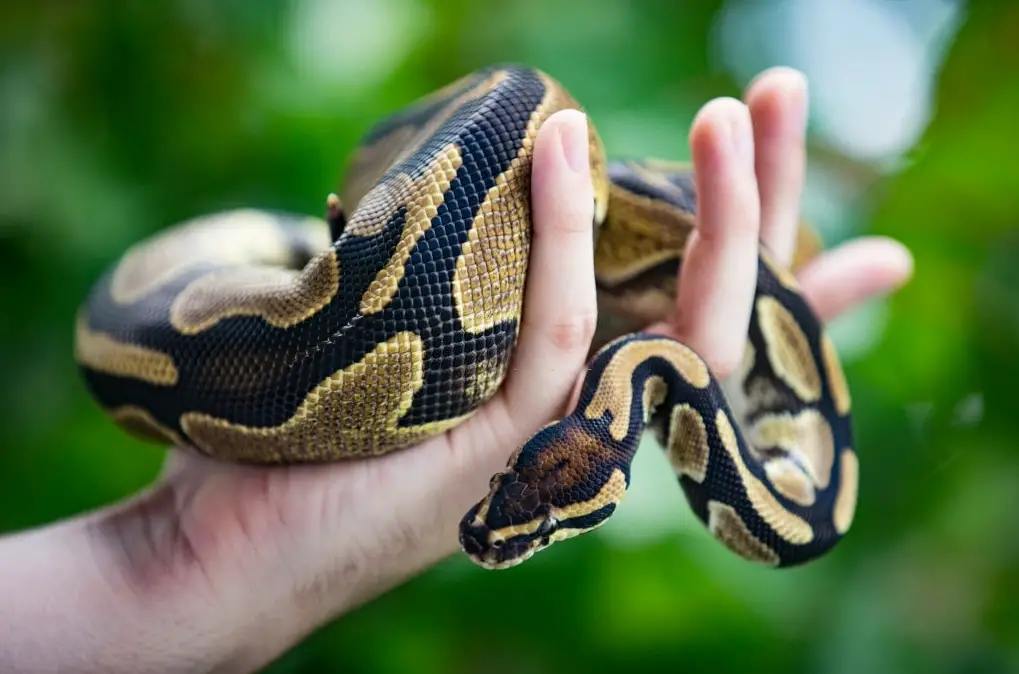Ball Pythons are one of, if not the most, popular pet snakes in the world. They are generally docile snakes and are not too nippy, even when they are juveniles. Ball Pythons are also known as Royal Pythons and they come from Sub-Saharan Africa.
Ball Pythons make great pets because they come in a huge variety of morphs and are active enough that watching them is an experience. They also handle well, which almost makes them the perfect snake.
Unfortunately, there are some issues. They can be very picky eaters and certain morphs do come with health problems.
Quick facts
| Common Name: | Ball Python, Royal Python |
| Scientific Name: | Python regius |
| Natural Habitat: | Sub-Saharan Africa |
| Adult Size: | 3 to 5 feet |
| Lifespan: | 20 to 30 years |
| Diet: | Rodents/small mammals |
| Experience Level: | Intermediate |
| Enclosure Size: | 3 long X 2 wide X 2 high |
Reptile Overview
Ball Pythons are not for beginners. They grow to a significant size and need an enclosure to match which requires more advanced care. They require a humid environment which can be difficult for beginners to manage.
They can become picky eaters if their environment or their food source is even slightly off. If you are a complete newbie, it might be difficult for you to identify why your Ball Python is not eating and you can watch your snake starve itself to death.
However, if you are up to the task of excellent care and enjoy handling and caring for a beautiful snake then a Ball Python is the one for you!
These are stunning snakes that are popular choices around the world. When purchasing your Ball Python make sure you research the breeder beforehand to ensure you are not getting a snake from the illegal pet trade.
Appearance
Physical attributes
The Ball Python has a typical python A-shaped head that ends in a blunt snout. Their head attaches to a thick neck which extends down to a chunky-looking body. The body then tapers right at the end to a short thin tail.
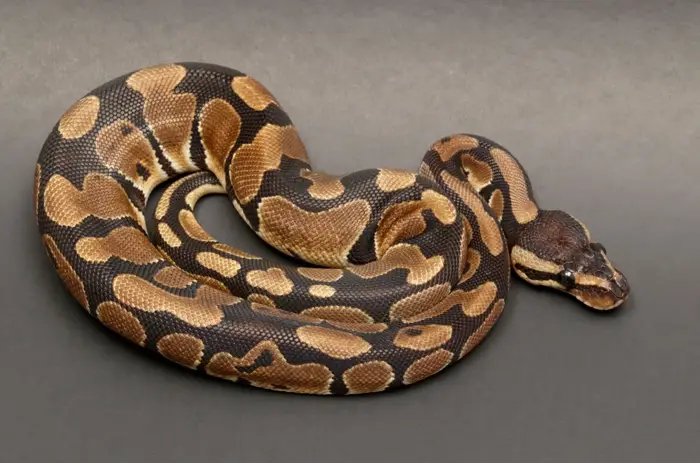
Ball Pythons are thickset and have a good girth which makes handling them a dream. This makes them ideal for being handled by children – under adult supervision of course!
The only visible sexual dimorphic trait is size. Females are larger than males and average at around 4 feet, occasionally they can reach 5 feet. Males average at about 3 feet and are slightly thinner than females.
The only foolproof way to know the difference in the sex would be to sex them.
Morphs
Trying to describe the markings of a Ball Python in a simple paragraph would be pointless because there are over 200 morphs and morph combinations!
Ball Pythons can range from pure black to pure white. They can be brown, lilac, orange, or yellow. They can have no markings, have a pied-type pattern, or can be covered in different patterns.

Price
Some morphs are worth more than others. It depends on how readily available the morphs are. Some morphs will sell for under $200!
Rarer morphs can go from $350 (Pied) to $5000 (Sunset) to $15,000 (Monsoon)! Whereas more commonly available and easier to breed morphs such as Pastels can be found for as little as $75.
Females will almost always be more expensive than males because of breeding capacity. One male can impregnate multiple females, but one female can only lay about 6 to 11 eggs once a year after she is three years old.
Some of the most expensive morphs are:
- Pied Ball Python,
- Clown Ball Python,
- Tri Stripe Ball Python,
- Desert Ghost,
- Highway/Freeway Ball Python,
- Puzzle Ball Python,
- Sunset Ball Python,
- Monsoon Ball Python.
Some of the least expensive morphs are:
- Fireball Ball Python,
- Pastel Ball Python,
- Lesser Ball Python,
- Spider Ball Python,
- Leopard Ball Python,
- Disco Ball Python,
- Black Pastel Ball Python,
- Orange Dream Ball Python,
- Spot Nose Ball Python,
- Blackhead Ball Python,
- Mojave Ball Python,
- Albino Ball Python.
Make sure you know what the genetic heritage of your Ball Python is before finalizing your purchase, especially if you want to set up a breeding program because some morphs come with mild to severe health issues.
Temperament
Ball Pythons are wonderfully docile snakes. They prefer flight over fight and are happy to be handled frequently. This is a great characteristic because they are the perfect size and temperament for comfortable handling, especially by children.
The juveniles can be slightly nippy but they do grow out of this if they are properly socialized.

Behavior
Ball Pythons are crepuscular snakes. This means that they are most active around morning and evening. If you want to watch your snake exploring its enclosure, then dawn and dusk are the times to do it.
When they feel threatened, Ball Pythons will roll their bodies up into a ball and tuck their heads under their coils. This is where their name comes from!
If they are feeling defensive or willing to strike, they will tense up their body and form an S-shape with their necks. They will visibly track the prey item or object that has caught their attention.
Learn to read your Ball Python’s body language to avoid handling them when they are in a bad mood.
Ball Pythons are mostly terrestrial (stay on the ground) and slightly arboreal! This means that they will venture into the vertical aspect of their enclosures if you provide them with perches and rocks to climb on.
Lifespan
Ball Pythons are long-lived snakes. Make sure you are ready for a 20 to 30-year commitment when buying this snake.
Enclosure
Dimensions
Ball Pythons can be kept in a rack system or 20-gallon tubs. However, they should be kept in 40 to 75-gallon enclosures for them to live a long, enriched, and happy life.
REPTI ZOO Large Glass Reptile Terrarium
A good rule of thumb to use is that your snake should be able to stretch out to its full length along two of the sides of the enclosure. If your snake is 5 feet long, then the length of the enclosure should be 3 feet, and the width should be 2 feet at least.
Because these are slightly arboreal snakes, the height of the enclosure should be equal if not more than the width of the enclosure.
Do not start your baby Ball Python in a 50-gallon enclosure. The enclosure should grow with the snake. So be prepared to upsize your enclosure as your Ball Python grows.
Type
We suggest using a PVC enclosure where the back, sides, and top are opaque and the front (door) is transparent. The PVC holds heat well and your snake will feel more secure with only one transparent wall.
A wooden enclosure might look good and more natural. Unfortunately, the Ball Python requires high humidity and wood will rot over time. Rotting wood is toxic to snakes and will cause a respiratory infection.
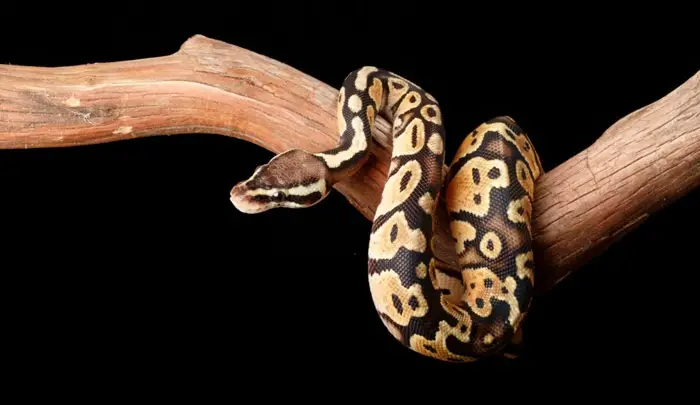
Layout and Enrichment
Your Ball Python needs a decent amount of enrichment in its enclosure. You can add branches, rocks, and plants to provide cover and things to climb on and under.
Your snake will need space to move around but should not feel exposed. Place the rocks and branches around the enclosure to provide some arboreal activity for your Ball Python. Use the foliage to provide cover and interesting places to explore.
If you want to use real plants, you might become a little disappointed as Ball Pythons are heavy and will crush most plant life. We recommend using fake plants that are safe and easy to clean.
You do not need to buy wood and rocks! You can use wood and rocks from your garden! Spray them down and leave them in the sun or in front of a heater to dry off before placing them in the enclosure.

Make sure they are free of mold and fungi! Any wood or rocks that you put in the enclosure should be sourced carefully to ensure that there were no pesticides or herbicides used in the area.
If you are unsure of the presence of harmful chemicals, bugs, mold, or fungi then you can sanitize them. Boil the wood/rock and then place it in the oven to bake at a low temperature to completely dry out.
Make sure all rocks and branches are secure and can hold your snake’s weight. You do not want a rock to roll onto your snake and crush it.
Hides
Your snake needs at least two normal hides. One on the coolest side of the enclosure and one on the warm side, it can even be in the basking spot.
These hides need to be large enough for the whole snake to fit in but small enough that it is a snug fit. The hides should be completely opaque. You can use an upturned plastic box, a half coconut shell, a cave, or a hollow log that is blocked off at one end.
These hides are essential to your snake’s health. They are there for your snake to retreat to when they are sleeping or need refuge.
There should be decent cover between the two hides so your snake does not go from feeling secure to exposed when they leave the hide.
Substrate
When you pick your substrate, make sure it holds humidity well.
Ball Pythons can be kept on newspaper, butcher’s paper, and paper towels. These are cheap and easy to replace materials.
We recommend using coconut husk/fiber and core mixture or safe topsoil and play sand. This does not need to be an expensive option! You can get large bricks of the coconut mixture from a hardware store.
Read the packaging carefully to make sure it has not been chemically treated!
Hydrate and mix this with some regular play sand that you can also get from a hardware store! Make sure it is not treated with chemicals or calcium! If it has calcium in it, it will encourage your snake to ingest the substrate which can cause a blockage.
Agitate the substrate daily to aerate it. While you do this, spot clean the enclosure for any messes.
You should clean out and replace the substrate once a month.
Do not let your snake live in its fecal mess as this will make it sick!
Try not to oversaturate the substrate. You should not be able to squeeze the moisture out of it. If you can then the substrate is too wet and the humidity will likely be too high.
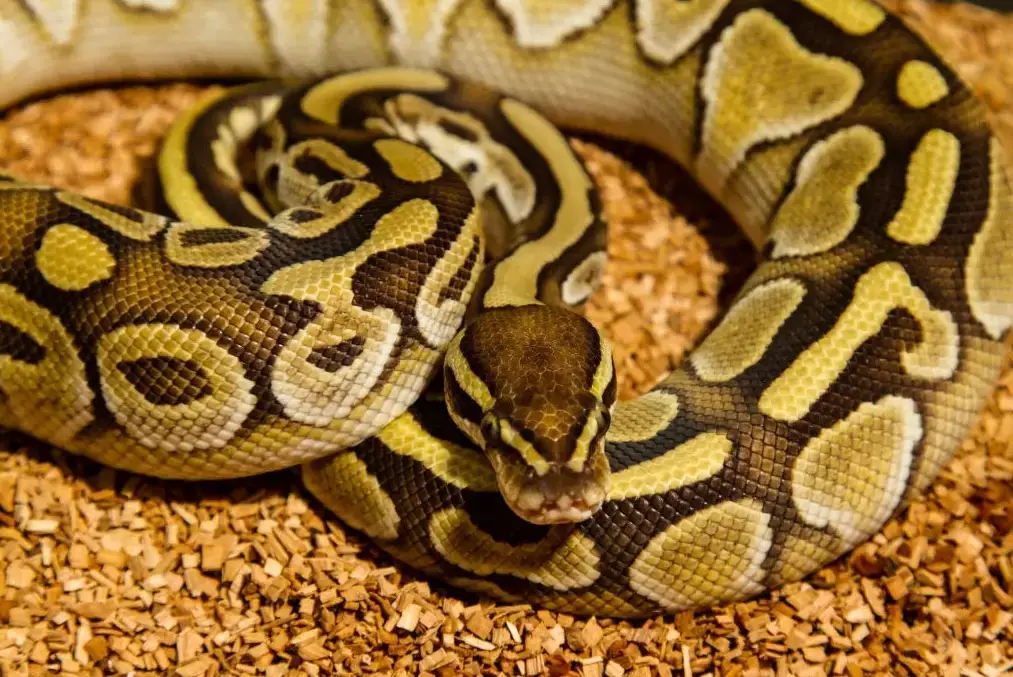
We do not recommend aspen shavings as they mold quickly in high humidity.
Do not use cedar or pine shavings! These woods contain oils that are toxic to snakes and can cause irritation and even burn their skin. The oils they release also cause respiratory infections.
Temperature
Your Ball Pythons needs an acceptable temperature gradient so that it can choose what temperature to be at for its various metabolic processes.
You create this gradient by placing all heat sources at one end of the enclosure and the enclosure will be coolest the further away from the heat sources it is.
We suggest using an under-tank heating pad connected to a thermostat. The heating pad should be under a third of the enclosure. It MUST be connected to a thermostat so you can make accurate adjustments to the temperature.
VIVOSUN Reptile Heating Pad with Digital Thermostat
The temperature should never fall below 75°F and never exceed 100°F.
- Cool Side: 75-80°F
- Warm Side: 85-90°F
- Basking Area: 95-100°F
To create the basking spot, you can either use a heat lamp or a ceramic heat emitter. Place the lamp or emitter in one corner of the hottest part of the enclosure. Make sure the lamp or emitter is in a protective dome so that your Ball Python cannot burn itself.
They should have a rock underneath the lamp or emitter that provides the perfect spot to soak up heat.
We NEVER recommend a heat rock. These rocks can burn and kill your reptiles.
Your enclosure should have a good-quality digital thermometer that reads the cool and warm ends of the enclosure. It is crucial to keep a careful eye on the temperatures and how they fluctuate throughout the day and night.
Zoo Med Labs Digital Hygrometer and Thermometer
Lighting
Your Ball Python needs a 12/12 light/dark photocycle.
We suggest placing your lights on a timer as to not make mistakes and to maintain a regular schedule. Remember, maintaining a regular schedule will help keep your Ball Python relaxed and healthy.
Your Ball Python does not need special full-spectrum lighting. Regular bulbs will do. Make sure the lighting does not increase the overall temperature of the enclosure.
You can keep your Ball Python in a room that has natural lighting, provided sunlight does not fall directly on the enclosure as this will raise the temperature enough to cook your snake.
Humidity
Humidity is key to a healthy Ball Python. Ball Pythons come from grasslands in Sub-Saharan Africa which aren’t very humid. However, they spend large amounts of their time in termite mounds which are very humid!
The humidity in the enclosure should never dip below 45% and should never exceed 65%. We recommend keeping the enclosure at a constant 50% and providing your Ball Python with a humid hide.

Use a good quality hygrometer to keep an eye on the levels. Place the probe in the middle of the enclosure and periodically check the humidity of the humid hide.
Humid hides work great for Ball Pythons because it simulates the termite mound experience that they would have in the wild.
The humid hide needs to be on the warmer side of the enclosure. Take a hide and line it with sphagnum moss. Mist the sphagnum moss regularly to keep it damp. The external warmth will encourage the evaporation of water in the hide and create a humid environment.
Galápagos Terrarium Sphagnum Moss
Play around with the humidity and your process to get it to the optimal range BEFORE your snake comes home.
Additionally, if you do not want a humid hide and decide to maintain an overall level of humidity level of about 55%, keep an eye out for when your Ball Python is in shed and then mist the enclosure daily to bring the humidity up to 60%.
FAQ: How long will it take for my Ball Python to shed?
Your Ball Python will shed every four to six weeks. From beginning to end it takes one to two weeks.
Once your snake has finished shedding, check it to make sure there is no stuck shed. If there is some shed that is stuck then you can soak it in some water or increase the humidity in the enclosure.
Diet
Water
Your Ball Python will enjoy a good swim now and then. Their water bowl needs to be:
- heavy-bottomed,
- nonporous as this will alter the humidity levels,
- large enough for your snake to get into, and
- deep enough that your snake won’t slosh water over the side and alter the humidity levels when getting in or out.
You must change the water daily or more often if you see fecal matter in it.
Food
We suggest feeding your Ball Python one prey item of appropriate size once a week. Use our prey sizing guide to help you:
Largest point of girth of prey = Largest point of girth of the snake
Adults may only feed once a month. That is perfectly okay as long as they maintain a healthy weight and remain active.
Ball Pythons will happily live off of mice and rats. However, it is a good idea to add in chicks and the occasional quail to vary their diet now and then.
We always recommend frozen/thawed prey. Frozen/thawed prey items do not carry parasites and cannot harm your snake. Feeding your snake live prey also comes with the additional costs of keeping that live prey in an ethical manner.
When it comes to feeding your snake, place the frozen prey item in a bowl of hot water until the prey is fully thawed. Never feed your snake partially frozen pray as the temperature difference will be fatal.
Always feed inside the enclosure! This is a safe place for your snake and removing the snake to a different area to feed will cause your already picky Ball Python to become even pickier.
FAQ: How do I feed my Ball Python?
Once you have thawed the prey item to the correct temperature, open your snake’s enclosure and, using tongs, wiggle the prey item near your snake.
If your snake does not go for it immediately, leave the prey item in the enclosure overnight. Leave it on a rock surface on the warmer end of the enclosure so the prey does not cool too quickly.
FAQ: How long can my ball python go without eating?
Ball Pythons can go about 6 months without eating. However, they can starve themselves to death if they feel that their environment is a stressful or unhealthy one.
FAQ: How do I get my Ball Python to eat?
- Check the that enclosure settings are right. Sometimes Ball Pythons go off feed when they are cold or the humidity isn’t right.
- Check the prey item is the temperature of a living mouse/rat. Remember that pythons have heat-sensing pits that they use to detect prey.
- If your Ball Python is still being a reluctant eater then you can scent the frozen/thawed prey item by braining it. Sometimes enhancing the smell of the prey is key.
- Reduce your handling before feeding days. Excessive handling can cause your snake enough stress that it won’t eat.
- Try an erratic feeding “schedule” to mimic natural hunting behaviors. Vary the length of time between feeds, vary the size and type of prey.
- Sometimes you just need to wait the snake out.
Before purchasing your Ball Python, ask the breeder how many successful meals it has had. This will give you an indication of how much difficulty you will have in feeding it.
Handling
Wash your hands before you touch your snake! Not only will it prevent parasite and bacterial contamination, it makes your hands smell like anything but food and will help prevent a bit.
Do not handle prey items before you handle your snake. This is confusing to them and may provoke a bite.
Ball Pythons are great snakes to handle. They are a good size and will fit in your hands nicely but not be dangerous like a Reticulated or Burmese Python.

It is a good idea to give your snake a key as to when it is going to be handled. Either gently stroke it with a hook and then hook it out of the enclosure. Or gently stroke it with a paper towel roll and then lift it while supporting its whole body.
Be prepared for your Ball Python to ball up. You still need to fully support your snake’s weight and not drop it. Carefully return it to its enclosure near a hide.
Do not:
- handle your snake for 24 hours before, during, or for 48 hours after feeding. This will cause your snake to stress and either refuse food or regurgitate it.
- handle your snake when it is in shed.
- handle your snake more than once a day.
- handle your snake more than twice a week.
Potential Health Issues
Parasites
All snakes are susceptible to parasites. Mites are a major concern for snake owners. They are visible as small black or red dots on your snake or the substrate.
Mites burrow under the scales to get at the blood and skin of your snake. If your snake has mites, it is an indication of poor enclosure hygiene. You will need to do a full sanitization of the enclosure and get your Ball Python treated for a mite infestation.
Scale and mouth rot
If the humidity levels are too high your snake can suffer from a bacterial infection of its scales, nostrils, or mouth. Scale and mouth rot must be addressed immediately by a vet.
Your snake will have a bright red mouth, skin irritation, or pus oozing from its nostrils.
Respiratory problems
If the humidity levels are too high your Ball Python will develop a respiratory infection. You will notice that your snake starts gurgling, wheezing, and bubbling from its mouth and nostrils.
Your snake will also tend to breathe through its mouth instead of its nostrils if it has a respiratory infection. It must be seen by a vet immediately and the humidity levels reduced.
Obesity
A fat snake is not a funny snake. Ball Pythons are not typically prone to obesity; however, it can happen especially if you are power-feeding your snake.
Obesity puts additional strain on the heart and liver and other internal organs and will lead to death. Stick to a structured feeding regime with your snake.
Anorexia
Anorexia is due to stress and refusal of food.
Morph related health issues
Research the morph that you are getting as some of them come with genetic health issues.
FAQ: What morphs should I avoid?
Neurological head wobble, this can be unnoticeable or be so bad the snake cannot move or eat properly: Spider Balls Pythons (a Blackhead combo cancels the issue), Champagne, Woma, HG Woma, Super Sable, Super Spot Nose (Powerball), Champagne.
Spinal Kinking, they cannot straighten out and food cannot properly pass through the digestive system: Caramel, Albino Caramel, Super Cinnamon, Super Black Pastel.
Duck Billing: Super Cinnamon, Super Black Pastel.
Bug Eyes: Super Lesser Platinum, Super Butter, Super Cinnamon, Super Black Pastel.
Tiny Eyes: Lesser Pied.
Infertility: Female Dessert only, the male Desserts are fertile.
Lethal, they either die in the egg or within their first year: Super Spider, Champagne Spider, Pearl (Super HG Woma), Champagne HG Woma, Super Woma, Sable Spider, Super Champagne.
Breeding
Ball Pythons are sexually mature at around 3 years old and can be bred provided they are in good health and are eating regularly.
The females should not be younger than 3 years old.
There is a question of whether you should breed Ball Pythons or not as there are already many breeders out there and many Ball Pythons on the market. Carefully consider this before you start breeding.
Ball Pythons need to be brumated before they breed. In the middle of winter, reduce their enclosure temperatures by 5°F and adjust their photocycle to 9/15 light/dark. Do this slowly.
Make sure you have not fed them for 2 weeks before cooling their enclosure as food that has not left their digestive system will rot as they need warmer temperatures to metabolize food correctly.
Maintain these settings for 2 and a half months. Then return the enclosure settings to normal slowly. You can offer your Ball Pythons food again.
Introduce the male to the female’s enclosure. Her scent will be stronger and there will be a higher chance of copulation. You can cycle males with various females or keep the same male and female together.
The female should ovulate anywhere from 6 days to a month after successful copulation. You will notice a large swelling in her belly which returns to normal in about 24 hours. You can now remove the male permanently.
In approximately a month she will go through a shed. Provide her with an egg-laying box that is lined in moist sphagnum moss. The box should be big enough for her to get into and turn around in.
About a month later she will lay her eggs. An average clutch had 6 eggs but it can go all the way up to 11. We recommend removing the eggs once she has laid them. Do not turn them upside down!
Incubate the eggs at 88°F on a bed of moist vermiculite. The eggs will hatch in about 2 months.
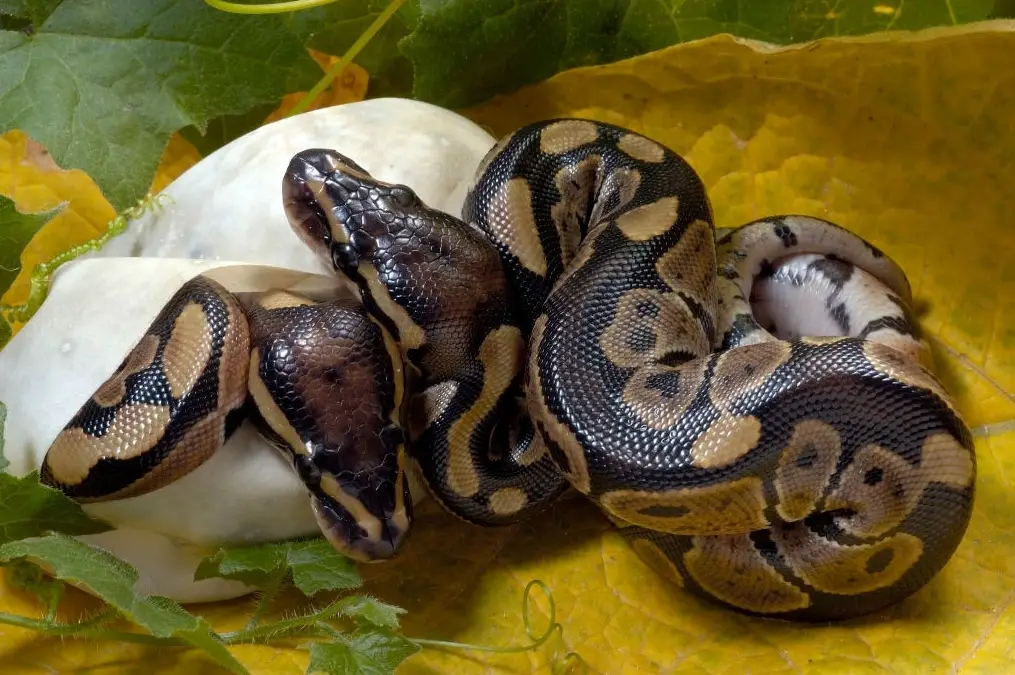
They will slit their eggs open with an egg tooth and then sit and absorb the yolk sac. Do not remove them until they have absorbed all of the yolk sacs. They will shed in about 2 weeks and can then be offered their first meal.
FAQ: How do I know what morphs my Ball Pythons will produce?
Morph Market has a calculator that will list all of the possible traits for the offspring of your two parent Ball Pythons.
FAQ: How do I sex a Ball Python?
Sexing should only be done by a professional! If you do not know what you are doing, you can permanently damage your snake!
Popping should be reserved for neonates and juveniles and probing should only be done to adults.
Probing: Using a probe, you insert it into the tail pocket/vent/cloaca. You aim the probe towards the end of the tail. If it goes in deeply then it is a male. If it is a shallow probe then it is a female. Always use a clean probe and a lot of lubricant!
Popping: Gently hold your snake’s tail at the cloaca/vent/tail pocket. Place a slight amount of pressure on the side closest to the end of the tail. If it is a male, the hemipenes will pop out, if it is a female, nothing will pop out. Do not bend or squeeze the tail!
Conclusion
Ball Pythons are awesome snakes to own. They are great for handling and provide endless hours of active viewing.
They come with several problems that you should always carefully assess before deciding to purchase one such as morph-related health issues, size requirements, and picky eating habits.
We “herp” you and our new best friend have an epic journey together and we wish you every bit of success!
Check Our Other Articles About Ball Pythons:

